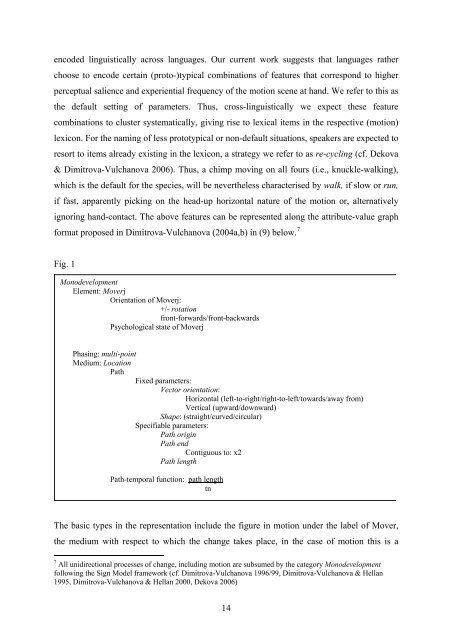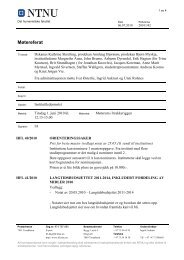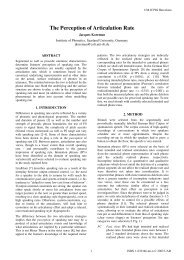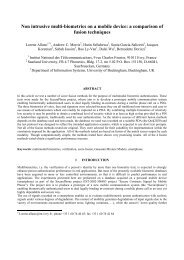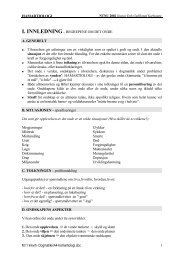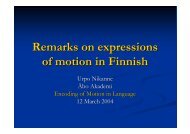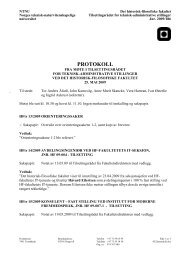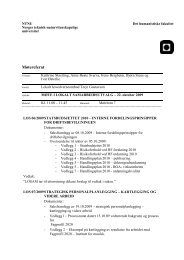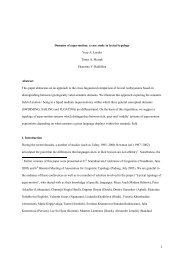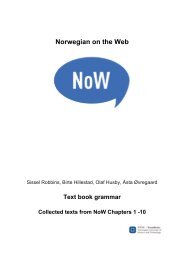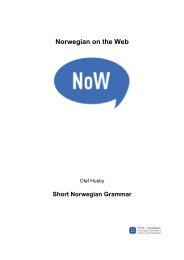In press: In: Dimitrova-Vulchanova, M - NTNU
In press: In: Dimitrova-Vulchanova, M - NTNU
In press: In: Dimitrova-Vulchanova, M - NTNU
Create successful ePaper yourself
Turn your PDF publications into a flip-book with our unique Google optimized e-Paper software.
encoded linguistically across languages. Our current work suggests that languages rather<br />
choose to encode certain (proto-)typical combinations of features that correspond to higher<br />
perceptual salience and experiential frequency of the motion scene at hand. We refer to this as<br />
the default setting of parameters. Thus, cross-linguistically we expect these feature<br />
combinations to cluster systematically, giving rise to lexical items in the respective (motion)<br />
lexicon. For the naming of less prototypical or non-default situations, speakers are expected to<br />
resort to items already existing in the lexicon, a strategy we refer to as re-cycling (cf. Dekova<br />
& <strong>Dimitrova</strong>-<strong>Vulchanova</strong> 2006). Thus, a chimp moving on all fours (i.e., knuckle-walking),<br />
which is the default for the species, will be nevertheless characterised by walk, if slow or run,<br />
if fast, apparently picking on the head-up horizontal nature of the motion or, alternatively<br />
ignoring hand-contact. The above features can be represented along the attribute-value graph<br />
format proposed in <strong>Dimitrova</strong>-<strong>Vulchanova</strong> (2004a,b) in (9) below. 7<br />
Fig. 1<br />
Monodevelopment<br />
Element: Moverj<br />
Orientation of Moverj:<br />
+/- rotation<br />
front-forwards/front-backwards<br />
Psychological state of Moverj<br />
Phasing: multi-point<br />
Medium: Location<br />
Path<br />
Fixed parameters:<br />
Vector orientation:<br />
Horizontal (left-to-right/right-to-left/towards/away from)<br />
Vertical (upward/downward)<br />
Shape: (straight/curved/circular)<br />
Specifiable parameters:<br />
Path origin<br />
Path end<br />
Contiguous to: x2<br />
Path length<br />
Path-temporal function: path length<br />
tn<br />
The basic types in the representation include the figure in motion under the label of Mover,<br />
the medium with respect to which the change takes place, in the case of motion this is a<br />
7 All unidirectional processes of change, including motion are subsumed by the category Monodevelopment<br />
following the Sign Model framework (cf. <strong>Dimitrova</strong>-<strong>Vulchanova</strong> 1996/99, <strong>Dimitrova</strong>-<strong>Vulchanova</strong> & Hellan<br />
1995, <strong>Dimitrova</strong>-<strong>Vulchanova</strong> & Hellan 2000, Dekova 2006)<br />
14


